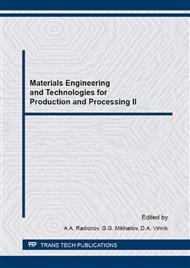p.265
p.271
p.276
p.282
p.286
p.293
p.298
p.303
p.309
Determination Features of the Component Diffusion Coefficients of the Fe-Cr-Ni-Gr Powder Systems Sintering
Abstract:
To predict structuring and to produce Fe-Cr-Ni-Graphite-based powdered alloys with tailor-made properties, the component diffusion coefficients have been determined that allow calculating sintering or homogenizing annealing parameters of heterogeneous charge products. It has been revealed that Fe, Cr and Ni heterodiffusion coefficients are influenced not only by their own concentration, but also by structuring kinetics and the number and distribution of the graphite in charge. The electron-probe test shows the distribution of the components in the in-terparticle contact zones. Using the Motano’s, the Lubov’s and the Maksimov’s methods, the values of mutual diffusion coefficients depending on the component concentration have been determined. Using Darken’s ratios and having experimentally determined the component interparticle zones and the displacement distance, the partial heterodiffusion coefficients have been calculated. The given paper proves that the powder-component grain-size distribution alloys should be selected on the basis of relative values of the heterodiffusion coefficients.
Info:
Periodical:
Pages:
286-292
Citation:
Online since:
September 2016
Authors:
Price:
Сopyright:
© 2016 Trans Tech Publications Ltd. All Rights Reserved
Share:
Citation:


